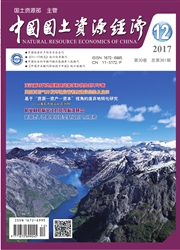

 中文摘要:
中文摘要:
以安徽省11个地级市为样本,构建区域建设用地集约利用评价指标体系,采用定性和定量相结合方法,确定建设用地利用集约度等级,分析各地级市建设用地集约利用现状、空间格局及时序演变特征.结果表明:(1)各地级市建设用地集约利用总体水平差距较大,多数城市在建设用地集约利用方面还有不少改进空间;(2)建设用地集约利用水平与各地级市的经济水平、区位、交通发展等因素密切相关,而经济、区位和交通之间的关联与互动在很大程度上影响区域建设用地集约现状和潜力.为此,要把加强区域建设用地集约利用管控作为国土管理工作的重要部分;可以根据评价结果,改进建设用地供给政策,实现各地级市的经济社会均衡发展.
 英文摘要:
英文摘要:
Taking 11 prefecture-level cities of Anhui province as samples to study, this paper has built index system for evaluating intensive use of regional construction land, determined intensive use level of construction land by the quantitative and qualitative method, and analyzed the status quo, spatial patterns, and temporal evolution characteristics pertaining to the intensive use of regional construction land of all prefecture-level cities. The results show that there are quite great differences in the general level of construction land intensive use among these cities, and most of these cities should be improved at a lot of parts. The intensive use level of construction land is closely related to the level of economic development, location, transportation development, and other factors of these cities. Moreover, the relationship and interaction between economy, location and transportation will affect intensive situation and potential of regional construction land to a great extent. In respond to this, this paper argues that we should enhance our efforts to control the intensive use of regional construction land, regarding this work as an important part of our efforts. In addition, based on the evaluation results, the policy of construction land supply must be improved with a view to achieving economic and social balanced development of all these cities.
 同期刊论文项目
同期刊论文项目
 同项目期刊论文
同项目期刊论文
 期刊信息
期刊信息
